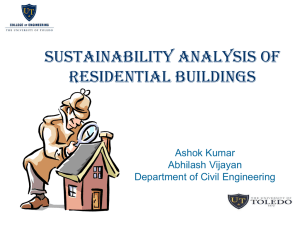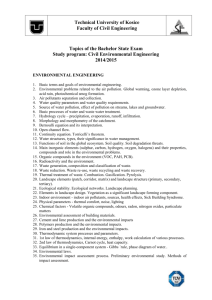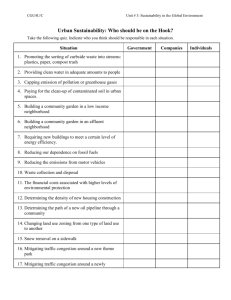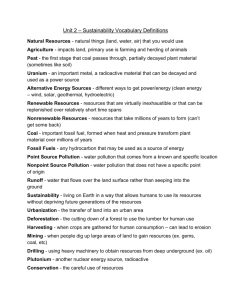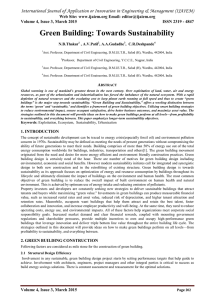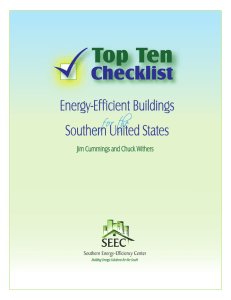An Approach towards Pollution Prevention
advertisement
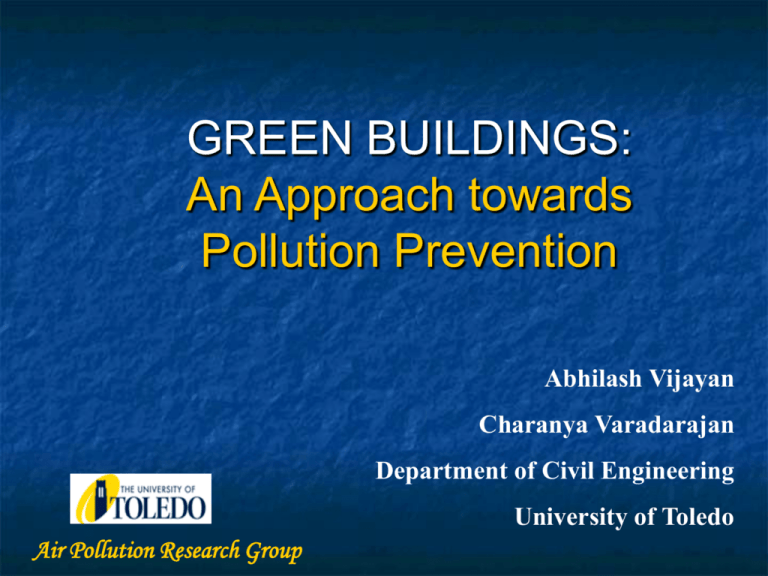
GREEN BUILDINGS: An Approach towards Pollution Prevention Abhilash Vijayan Charanya Varadarajan Department of Civil Engineering University of Toledo Air Pollution Research Group Introduction Since the Industrial Revolution the world has witnessed incalculable technological achievements population growth corresponding increases in resource use “Side effects” of all the activities and achievements include: pollution, landfills at capacity, toxic waste, global warming, resource and ozone depletion, and deforestation All these efforts are straining the limits of the Earth’s “carrying capacity”— its ability to provide the resources required to sustain life while retaining the capacity to regenerate and remain viable. Building Industry- Facts Population Vegetation Air Quality Climate Construction Transportation Watersheds 1/6 of the world’s freshwater withdrawals 1/4 of world’s wood harvest 2/5 of world’s material & energy flows Environmental and Economic Impacts of Buildings 16 Fresh Water Withdrawals 25 Timber Harvest 30 Raw Materials Consumption 35 Global CO2 Emissions Global Energy Use 40 Municipal Solid Waste to Landfills 40 50 Ozone depleting CFCs in Use 0 10 20 30 Percentage Compiled from:Worldwatch Paper #124 40 50 Building Industry in US Represents more than 50 percent of the nation’s wealth New construction and renovation activity amounts to approximately $800 billion Represents 13 percent of the GDP Employs over ten million people C&D debris comprise approximately 15 to 30 percent of all waste disposed of in landfills The resources required to create, operate, and replenish this level of infrastructure and income are enormous, but diminishing To remain competitive and continue to expand and produce profits in the future, the building industry has to address the Environmental and Economic consequences of its actions Sustainability SUSTAINABLE DEVELOPMENT Development that meets the needs of the present without compromising the ability of future generations to meet their own needs (The Brundtland Commission,1987) SUSTAINABLE BUILDINGS A “Cradle-to-Cradle” Approach Working Principles Application of Sustainability Pre-Design On-Site Design Material Selection Construction Building Program Site Analysis Environmentally Project Budget & Assessment Conscious Team Selection Site Development Construction Partnering & Layout Preservation of Project Schedule Watershed Laws, Codes Management & & Standards Conservation Research Site Material Site Selection & Equipment Passive Solar Design Materials & Specification Indoor Air Quality Features & Vegetation Waste Mgmt IAQ Issues Source Control Practices O&M Maintenance Plans Indoor Quality Energy Efficiency Resource Efficiency Renovation Housekeeping & Custodial Practices Application of Sustainability – A Superior Technology Effect of Sustainability Advanced Features of a Sustainable Building Best Solar Building Form & Energy Efficient Design Improved Indoor Air Quality Usage of Green Materials Proper Mechanical Systems Efficient Proper Lighting Testing & Maintenance Green Materials Materials, production, use and disposal must be safe for the planet. Most of the materials have specific range of conditions in which they best work Sustainable building materials have the following features: • Durable and easily maintained • Less processing required • Low odor • Low emitting • Cost-effective • Aesthetic Economics of Green Buildings Reduction in lighting energy requirements by at least 50 percent Cut heating and cooling energy consumption by 60 percent Reduced water consumption by up to 30 percent or more Lower building operating expenses through reduced utility and waste disposal costs Lower on-going building maintenance costs, ranging from salaries to supplies Increase worker productivity by six to 16 percent Higher property values and potentially lower lenders’ credit risk Higher building net income New economic development opportunities Benefits of Sustainable Construction Sustainable construction makes wise use of all the natural resources and a 50% reduction in energy use Improves occupant health, comfort, productivity, reduces pollution and landfill waste that are not easily quantified A sustainable building may cost more up front, but saves through lower operating costs over the life of the building Building is designed as one system rather than a collection of stand-alone systems with the help of the integrated system approach Future of Sustainable Buildings •Further research •Successful examples of Sustainable buildings •Newer, efficient and healthier technologies •Availability of computer software programs to identify and evaluate options for a building project •Governmental support •An active participation from every sector of the society Case Study- The Dalles Middle School (Oregon) (Source: http://www.energy.state.or.us/school/thedalles.pdf Problem: Poorly built middle school in a landslide area In 1955, to meet the sudden influx of students, temporary facilities were constructed with an expectant life of 20 years, but were used for 45 years By 2000, the State Fire Marshall closed down the facility with the decision to build a new school Building Design Heating and cooling are a large part of the energy use of a school building The high temperature ground water from the landslide area was used to provide both heating and cooling using geothermal principles It is one of the first schools in the nation that is heated and cooled with the very ground water that caused the landslides Lighting Daylighting & SkylightingIncorporated lots of natural light to reduce the need for electric lighting and the associated increase in the air conditioning load Energy efficient fluorescent T5s installed Natural Ventilation Operable windows pull fresh air into one side of the classroom, while ventilation stacks pull the air out on the opposite side of the classroom At extreme temperatures, automatic backup mechanical ventilation systems used Application of Concepts of Sustainability Use of paints and sealers with low or no-volatile organic compounds (VOCs) Reclaimed ground water to irrigate the ball fields. Exterior lighting directed downward to reduce night light pollution Mechanically zoned science classrooms to avoid exposure to hazardous chemicals Stained the concrete walls to blend with the colors of the natural landscape Use of ceiling tiles produced from 75 percent Results High performance school building emerged that will prevent pollution, save energy, natural resources and money 60 percent cost reduction in energy expected Students performed better with the skylights and windows that bring natural, non-glare light inside the classroom Improved Indoor Air Quality and occupant comfort due to no-VOC emissions from building materials
